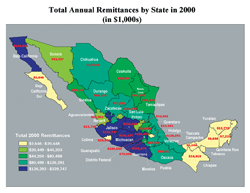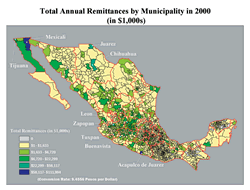GIS Tracks Earnings Sent Home by Mexican Migrants
By German Z�rate-Hoyos and Scott W. Anderson, State University of New York, Cortland
 |
| The researchers observed the general geographic distribution of remittance was as expected-states that traditionally sent more migrants to the United States are the ones with the largest volume of remittances.
|
Globalization has brought not only increased trade and financial flows but also an increase in migration. According to the International Organization for Migration (IOM), there are more international migrants worldwide today than at any other time in human history. IOM currently estimates that more than 150 million international migrants are scattered around the world.
One effect of this migration has been that flows of money, in the form of remittance payments from migrant workers to their families back home, have also reached record levels. An article published in March 2004 by BBC News Online estimated that remittance payments reached $140 billion in 2003.
With such a gigantic market, banks and other financial institutions have begun competing to find more efficient ways to help migrants send their earnings back home. However, making the process cheaper, quicker, and more convenient for clients requires a much better knowledge of the geography of migration.
One Big Tent, a money transfer company in Los Angeles, California, asked economist German Z�rate-Hoyos and geographer Scott Anderson for help in launching their business in Mexico. Z�rate–Hoyos has published extensively on the impact of remittance payments on Mexican communities. (See the accompanying article, "The Importance of Remittance Payments.") Anderson is an experienced GIS professional. His article, "GIS Assists Public Health Campaign in Thailand," appeared in the July–September 2002 issue of ArcUser magazine. They are both professors at the State University of New York, Cortland. Z�rate-Hoyos and Anderson agreed to work with One Big Tent because the company was committed to lowering the cost of transfer fees to Mexican migrant workers and planned to donate some profits to foster local development.
To make transfer centers both economical and profitable, the executives at One Big Tent recognized they needed a better understanding of the concentrations of remittance flows in certain Mexican municipalities. To determine optimal locations for the receiving offices that were planned, they recognized that a fine-grained GIS analysis of the geography of remittance payments from Mexican workers in the United States to their hometowns in Mexico was essential.
 |
| The unequal distribution of remittances is shown not only at the state level but also within states. One municipality in Michoac�n, Acapulco de Juarez, has the highest volume of remittances in the country. |
Because datasets were readily available, Z�rate–Hoyos and Anderson were able to provide this analysis in a timely manner. Data on family remittances was available at the state and municipality levels from the Mexican 2000 Population Census. There are 2,443 municipalities in Mexico, each containing an average of 40,000 persons. Data on social remittances came from fieldwork done by Anayatzin Larios Candelas, a graduate student in the applied economics program at El Colegio de la Frontera Norte, Tijuana, Mexico, as part of her master's degree dissertation.
Z�rate–Hoyos served as the principal advisor for this dissertation. A common problem in estimating remittance flows is the difficulty in capturing "informal" flows such as money sent through letters or carried by migrants or their relatives on return trips across the border. Both project data sources used surveys of the receivers, rather than the senders, of remittances, which alleviated this problem and made both datasets quite reliable.
Using ArcView 3.2a, Anderson prepared a series of maps using this data. One Big Tent executives brought these maps before their board when choosing the locations for new receiving offices. (The locations of these new offices are confidential.) For One Big Tent, this is just the beginning of the company's use of GIS for making more informed business decisions.
According to one executive, within a three-year period, One Big Tent plans to provide service from the United States to other Latin American and Caribbean countries including El Salvador, Guatemala, Nicaragua, Honduras, Dominican Republic, Haiti, Cuba, Colombia, Ecuador, and Jamaica. One Big Tent will also provide service to several European countries-Poland, Germany, Russia, and the Ukraine.
Service from the United States to Asia will include South Korea, the Philippines, India, and Bangladesh. In Africa, service is planned for Ethiopia, Nigeria, and Ghana, and the company also wants to provide service from the United States to Peru and Brazil. Z�rate–Hoyos and Anderson could complete the Mexican analysis quickly because data was readily available. However, for the other countries, the collection of reliable data presents a significant challenge.
The Geography of Remittance Payments
As the maps produced by this project demonstrate, Mexican migration to the United States has a specific geographic distribution. For the last 80 years, more migrants have come from four states—Guanajuato, Jalisco, Michoac�n, and Zacatecas—and these states have also consistently received the most remittance payments. However, recent data shows significant changes in this geography.
In the last few years, traditional migrant-sending states in northwestern Mexico—Durango, Jalisco, and Zacatecas—have lost ground to states such as Nuevo Leon and particularly the Distrito Federal. These states now represent a larger proportion of total migration flows. Today, M�xico, San Luis Potos�, Veracruz, and in particular the Distrito Federal—states that received less than 1 percent of total remittances as recently as 1995—now receive between 4 and 6 percent of these payments. Although more than 90 percent of Mexican municipalities received some remittance payments in 2000, just 20 percent (or 463 of 2,443 municipalities) received almost half the total.
For states with a significant number of migrant workers, remittances are extremely important. These states receive significantly more funds from remittances than from federal spending. Remittances to Guanajuato are 14 times greater than all federal social expenditures in that state. In Hidalgo, Puebla, Oaxaca, and Veracruz, remittances represent 100 percent more than all federal outlays in these states.
These trends make the money transfer industry increasingly important to Mexican communities. Despite growing competition, the cost of money transfers remains high in many places. According to the World Bank, money transfer fees amounted to $12 billion worldwide in 2002. During the 1990s, almost 15 percent of Mexican remittances went to financial intermediaries and money transfer businesses rather than low-income households. While competition has brought the charges down to approximately 5 percent, fees still remain too high. Solid information for optimizing business locations is essential to bringing down money transfer costs.
Continued on page 2
|